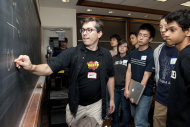|


|

Springfield State Journal Register
Home-school students make transition to higher education smoothly, thanks to a plethora of resources and social acceptance
By Amy Choate-Nielsen
When Cade Taylor considers what career he’ll choose, there’s a little voice in the back of his mind that inspires him to aim high.
It sounds like his mother.
Taylor is a college freshman who, up until now, has been home-schooled by his mom his whole life, but the next step after college is one he hopes will make her years of sacrifice all worth it, he says.
“I feel guilty I took up so much of her time,” Taylor says with a little laugh. “I feel like I have to succeed at something to make myself feel like her spending all of that time on me was worthwhile – so I have to do something cool with my life.”
Taylor is one of a growing population of home-schooled students whose first experience with a brick and mortar school is walking onto a college campus. As the rate of students attending home school is increasing, so too is the rate of home-school students attending college, thanks to a marked increase of available resources and a softening of public perception.
Now more home-school students than ever are making the transition to college life with better skills and preparation in some cases than their non-home-schooled peers, studies show. The 20-year-old Taylor wants to make his mother proud by becoming a pediatrician or an anesthesiologist. Data comparing home-schooled students’ scores and skills to his non-home-schooled peers show that his mother’s investment might already be worth it.
The home-schooling choice
Lisa Taylor, Cade Taylor’s mom, didn’t initially plan on home-schooling her kids.
Years ago, she was in college herself, majoring in biology and English, with plans to go on to graduate school, when she had her first baby – a little girl who was diagnosed with Down syndrome. From that point on, her life changed.
Parents choose to home-school their children for a variety of reasons: they like the freedom of setting their own schedule, they like having a flexible curriculum or they have ideals not being met by a standard school setting. Lisa Taylor did it because she thought it would be fun. For the most part, she says she was right.
“Especially if you start when they are young, it becomes your lifestyle; it becomes something you do,” Lisa Taylor said on a recent fall afternoon from her home in Herriman, Utah. “There are some days that aren’t as fun as others. And there are some days when you think, ‘Why am I doing this? I could be out shopping someplace.’ “
Even though Lisa Taylor didn’t initially plan on being a home-school mom, her family fits the mold of home-schoolers pretty well. Families that home-school their children generally have more formal education than the general population, according to “Homeschooling Across America: Academic Achievement and Demographic Characteristics,” a study published in 2009 by the National Home Education Research Institute. The study was commissioned by the Home School Legal Defense Association, a nonprofit group that promotes home-schooling across the country. According to the study, 66.3 percent of fathers and 62.5 percent of mothers had a bachelor’s degree or higher.
Read more: http://www.sj-r.com/article/20131030/NEWS/310309905/0/SEARCH#ixzz2uTDstOQ6

|
|||||||||||||||||||||||||||||||||||||||||||||||||||||||||||||

 Raspberry Pis just became a bit easier to get ahold of in the United States. Beginning last week, some RadioShack locations started carrying MAKE’sRaspberry Pi Starter Kit, which includes a Raspberry Pi Model B, power supply, SD card with NOOBS preloaded, HDMI cable, a case, prototyping components and a print and PDF download of Getting Started with Raspberry Pi.“If we’re going to reach our goal of teaching a whole new generation of children coding and making skills it’s important that Pi should be easily available,” said Eben Upton, co-founder of the Raspberry Pi Foundation. “Having it in retail alongside a great kit and documentation is a big part of that.”At the location I visited on 6th Avenue in New York City, the kit was available along with Maker Shed’s Ultimate Arduino Microcontroller Pack, and Getting Started with the BeagleBone Black Kit.
Raspberry Pis just became a bit easier to get ahold of in the United States. Beginning last week, some RadioShack locations started carrying MAKE’sRaspberry Pi Starter Kit, which includes a Raspberry Pi Model B, power supply, SD card with NOOBS preloaded, HDMI cable, a case, prototyping components and a print and PDF download of Getting Started with Raspberry Pi.“If we’re going to reach our goal of teaching a whole new generation of children coding and making skills it’s important that Pi should be easily available,” said Eben Upton, co-founder of the Raspberry Pi Foundation. “Having it in retail alongside a great kit and documentation is a big part of that.”At the location I visited on 6th Avenue in New York City, the kit was available along with Maker Shed’s Ultimate Arduino Microcontroller Pack, and Getting Started with the BeagleBone Black Kit.
Matt Richardson is a Brooklyn-based creative technologist, Contributing Editor at MAKE, and Resident Research Fellow at New York University’s Interactive Telecommunications Program (ITP). He’s the co-author of Getting Started with Raspberry Pi and the author of Getting Started with BeagleBone

Online Courses Satisfy Criteria for University of California’s a-g Subject Area Requirements
Scottsdale, AZ – November 13, 2013 – Edgenuity, a leading provider of online and blended learning solutions, announced that a number of its courses have been reviewed by the University of California Office of the President (UCOP) and found to meet its a-g subject area requirements, with approval through the 2015-2016 school year. The requirements outline a curriculum of key content areas, such as English, history and laboratory science, among others, that students must master in order to meet UC’s eligibility standards.
Edgenuity’s suite of courses that received a-g approval recently include Biology; Chemistry; Common Core English Language Arts; Common Core Mathematics; World History, Culture & Geography; Economics; Principles of American Democracy; and U.S. History & Geography. Psychology and Sociology were previously approved.
“Edgenuity and the University of California system share the mission of cultivating self-directed learners who are motivated toward academic achievement,” said Sari Factor, CEO of Edgenuity. “We are confident that the robust suite of Edgenuity courses receiving a-g approval will support schools in offering the engaging and dynamic curriculum they need to prepare students for college and career success.”
For the first time this year, online courses had to first receive California Learning Resource Network (CLRN) certification before they could be submitted to the University of California’s Office of the President (UCOP) for a-g review. To earn CLRN certification, online courses must address at least 80% of the course’s content standards and 80% of iNACOL’s Standards for Quality Online Courses. The a-g requirement, established by UC faculty in 2008, ensures that students take college preparatory courses in high school and can participate fully in the first-year program at the University in a wide variety of fields of study. The requirements are written deliberately for the benefit of all students expecting to enter the University and ensure the rigor of high school courses.
Edgenuity’s current a-g approved course list can be found at: https://doorways.ucop.edu/list.
About Edgenuity
Edgenuity (formerly E2020, Inc) provides engaging online education solutions that propel success for every student, empower every teacher to deliver more effective instruction, and enable schools and districts to meet their academic goals. Edgenuity delivers a range of Core Curriculum, AP®, Elective, Career and Technical Education (CTE), and Credit Recovery courses aligned to the rigor and high expectations of state, Common Core and iNACOL standards and designed to inspire life-long learning. Fully flexible for use in any blended or online learning model, Edgenuity supports an environment where personalized learning is possible. With 185 semester-long courses and growing, Edgenuity has already driven outcomes for more than one million students in schools and districts across the country. For more information, and to see Edgenuity in action, visit Edgenuity.com.

|
|||
|
|

Learning to code is all the rage these days, but not in one place that matters a lot: U.S. schools.
U.S. students already significantly lag their global counterparts where math and science skills are concerned. But computer science is in even worse shape: Of 12 technical subjects 
Schools Aren’t Teaching Kids To Code (Here’s Who Is Filling The Gap)examined in a recent study by the National Center for Education Statistics, computer science was the only one that declined in student popularity from 1990 to 2009 (p. 49).
Last year, just 1.4 percent of high school AP students took the computer science exam, compared to almost 40 percent that took exams in English. Far more students took AP exams in Spanish language, psychology, calculus, and history than in programming.
Insufficiencies in school can translate into a bigger problem on an economic level. Each year, U.S. companies need to fill almost150,000 jobs related to computer science and mathematics, but colleges and universities only graduate about 100,000 students with degrees in those fields.
Recognizing the need for an increased focus in computer science courses in schools, organizations like the nonprofit Code.org are teaming up with industry leaders to promote technology education in both elementary and high schools across the country.
Code.org believes all students in America should have the opportunity to learn computer science, and recently announced the first step in its plan to educate them. The Hour of Code initiative is a one-hour introduction to computer science, designed to help kids and educators understand coding. The organization will provide both online and “unplugged,” or paper, tutorials and materials designed to assist teachers with the education process.
“Bringing computer science to every kid is the gift the tech industry needs to give back to America,” Code.org cofounder Hadi Partovi said during the Hour of Code launch event on Monday.
The Hour of Code will take place during Computer Science Education Week, December 9-15, and will encourage teachers to include one hour of computer science in that week’s curriculum. The organization is using game-like tutorials including Angry Birds and Plants vs. Zombies to drum up excitement for coding in the classroom.
Code.org is supported by leaders in technology and education including Bill Gates, Mark Zuckerberg, former president Bill Clinton, NBA star Chris Bosh, and actor Ashton Kutcher.
Paypal cofounder Max Levchin said that teaching young students how to code is critical for maintaining economic competitiveness in the 21st century.
“I think learning how to code, learning how the vast majority of everything around them works, literally, that is to say Internet of Things, and many other trends like it,” he said. “Having that knowledge will prepare children in the generations to come to participate in the economic development of the world.”
To meet the growing need for computer science literate individuals, Beaver Day Country School, an independent college prep middle and high school just outside Boston, now requires students to have coding experience in order to graduate. Rather than requiring students take a standalone coding course to graduate, Beaver’s educators are incorporating coding practices into classes like math, science and even English.
“We also recognize that coding is a mindset, so we don’t want our students to memorize a certain list of commands within a certain programming language,” said Rob MacDonald, the school’s math department head. “Instead, we want them to think about solving problems in innovative ways.”
Learning programming and computer science builds problem-solving skills and critical thinking that can inform other walks of life.
“We’re also planning an interdisciplinary project in which students will learn about the history of surveillance, including the recent controversies around the NSA and Wikileaks,” MacDonald said. “That project will incorporate history, English and math, and teachers from all three departments will work together on the curriculum.”
Beaver has witnessed the success of coding firsthand. Last fall, a group of students from the Beaver InvenTeam received a $10,000 grant from the Lemelson-MIT program to build “an automated robot vehicular independence system,” or a robot that can follow motion sensors while carrying up to 50 pounds of weight. The school will begin implementing the coding classes for upperclassmen, but will expand all the way down to sixth-graders in the future.
Of course, Beaver Day’s approach isn’t for everyone—tuition for the 2013-2014 school year is $39,950, and the school enrolls a total of 457 students—but it’s definitely an intriguing model.
While the idea of mandating computer science classes on the path to graduation is an impressive notion, many schools and organizations are finding it challenging to educate and keep teachers who develop technical skills. “I can say pretty confidently there are multiple challenges, but the biggest by far is the lack of teachers,” Code.org’s Partovi said.
To make up that shortage, many students turn to mentors or peers outside the classroom to assist with projects like building websites or mobile applications.
“I know some students that say, ‘I would have loved to learn more about technology, but my friends, teachers or parents didn’t know much about it’,” said Edward Jiang, CEO and founder of StudentRND. “Building an app was far off magic that no one understood.”
Jiang started StudentRND, an organization that inspires the next generation of technologists and encourages people to work on projects in their free time, after teaching himself how to build websites and online games in high school.
He noticed that many students don’t have the time or the place to explore topics like programming. So he created Code Day, a 24-hour event that brings together high school and college students to build projects.
Because of his program and others like it, students get the opportunity to connect with peers and mentors that share their passion for computer science and can build and develop projects they would have struggled with pursuing on their own.
StudentRND and Code.org both recognize the importance of qualified mentors as an impetus for students to pursue interests in computer science.
“My first exposure to code and programming was actually in a neighborhood workshop,” said Levchin, who grew up in the Soviet Union. “But it’s remarkable that a backwards country like the Soviet Union had [resources for] learning how to code. And industry people, and software developers from the defense program that were teaching kids how to code.”
By 2020, computer-related employment is expected to rise by 22 percent. That means students must be ready to enter a workforce that expects them to have polished technological skills.
Lead image via HackNY on Flickr, other media via Code.org


Getty
Increasingly, educators are looking to research about how kids learn to influence teaching practices and tools. What seemed like on-the-fringe experiments, like game-based learning, have turned into real trends, and have gradually made their way into many (though certainly not most) classrooms.
BRAIN-BASED TEACHING
Many educators are using researchers’ insights into how children best learn to inform their teaching practices. Stanford professor Carol Dweck’s research on encouraging children to develop a growth-mindset continues to grow in popularity, as educators try to praise effort, not outcomes. Dweck writes that if children believe their abilities are fixed — that either that they’re smart or they’re not — they approach the world in different ways and aren’t as able to face adversity. When they believe skills and abilities can grow throughout one’s lifetime, they’re better able to rise to challenges.
Brainology, Dweck’s program, is just one of many such school-based programs that teachers can use in classrooms, as is Brainworks.
Educators are also teaching learning strategies, helping students find out the best ways to not just learn content, but how to learn. Ideas like remembering facts when they are set to music. This practice has been employed since the days of oral storytelling, but teachers are reviving it to help students in modern classrooms. Recent studies show that adults learn new languages more easily when they are set to a beat. Some educators are even experimenting with breaking up classical literature into bite sized raps.
There are plenty more examples of brain-based research on learning making its way into classroom practices.
GAME-BASED LEARNING
Games have long been used to engage students. But as game-based learning becomes more prevalent in schools, researchers are interested in how game structure mirrors the learning process. In many games, students explore ideas and try out solutions. When they learn the skills required at one level, they move up. Failure to complete tasks is reframed as part of the path towards learning how to conquer a level.
Universities like Harvard, MIT and the University of Wisconsin’s Game and Learning Society are studying how game-playing helps student engagement and achievement, and well-known researchers in the field like James Paul Gee and University of Wisconsin professor Kurt Squireshow are using their own studies to show that games help students learn.
Once the terrain of experimental classrooms, digital games are now becoming more common in classrooms. In a recent survey by the Joan Ganz Cooney Center, half of 505 K-8 teachers said they use digital games with their students two or more days a week, and 18 percent use them daily. Educators are using commercial games like Minecraft, World of Warcraft and SimCity for education. The Institute of Play continues to study game-based learning and helps support twoQuest to Learn schools, which are based around the idea of games and learning.
POWER OF PERSEVERANCE
Paul Tough’s book, How Children Succeed, popularized the ideas of grit and perseverance. Now those ideas have made their way into a U.S. Department of Education’s Technology office reportas well as the Common Core State Standards, which many states are already implementing. The idea that failure is an opportunity to learn and improve, not a roadblock to achievement, is often referenced as one of the most important life skills a student can take with him beyond the classroom.
Angela Duckworth’s research on grit has shown that often students, who scored lower on intelligence tests, end up doing better in class. They were compensating for their lack of innate intelligence with hard work and that paid off in their GPAs. Duckworth has even developed a “Grit Scale” that allows students to self-report their “grittiness.”
QUESTIONING HOMEWORK
The growing movement against homework in the U.S. challenges the notion that the amount of homework a student is asked to do at home is an indication of rigor, and homework opponents argue that the increasing amount of “busy work” is unnecessarily taking up students’ out-of-school-time. They argue that downtime, free play, and family time are just as important to a child’s social and emotional development as what happens in school.
Some research has shown that too much homework has “little to no impact” on student test scores. Other research on how brains work challenges the common method of asking students to practice one discreet skill at home. Overall, there’s a push to reevaluate the kinds of work students are being asked to do at home and to ask whether it adds value to their learning. If the work is repetitive or tangential, it may add no real value, and teachers across the country are starting to institute no-homework policies. Even principals are starting to revolt and schools are instituting “no homework” nights or substituting “goals” for homework.
CULTIVATING CREATIVITY
Increasingly business leaders and educators are realizing that creativity is a uniquely human quality that will set future graduates apart from the ever smarter computers that are playing increasingly important roles in society. There’s been a focus on stimulating curiosity and creativity through Science Technology Engineering and Math (STEM) courses, including computer coding, as well as integrating art and design into courses. The design thinking movement is a good example of schools working to develop students’ ability to think for themselves, brainstorm ideas and execute them.
Many schools are also shifting towards project-based learning to help leverage student interestsand passions in their school work. Long-form projects often allow students to demonstrate their creativity more than assignments that every student must complete the same way. The trend towards project-based learning is one indication that schools are actively looking to build creativity into curricula.


At the Education Nation summit over the past few days a recurring theme has beenhow new tech tools can improve education and tackle soaring costs. A relatively new category of “EdTech” start-up looks to use technology to make education more effective and accessible to hundreds of millions of people.
“Anyone in the world should be able to take high-quality courses, whether at the college or high school level,” said Anant Agarwal, the president of nonprofit EdX, which makes college courses available online. “They should be able to take it freely, maybe pay a small amount to get a credential.”
Huge demand for education improvement and massive upside potential is driving a surge of investment. The amount of venture capital funding going into Ed Tech has quadrupled, from $154 million in 2003 to $630 million in 2012. The number of companies funded has also quadrupled, to 95 last year—a sign of the explosion of interest from entrepreneurs.
“We’re now in this age where anybody can learn anything, anywhere,” said Tom Vander Ark, founder of Learn Capital, the first VC fund focused on such start-ups. It has invested $60 million into 40 Ed Tech businesses. “With the explosion of mobile devices and open content, [it has] really made it possible for anybody on the planet to access the best professors in the world,” he added.
We’re on the precipice of major change thanks to technology—giving students a more social and connected experience, while “gamification” keeps them engaged, according to Vander Ark.
“In the second half of this decade, with inexpensive tablets, with open content, we’ll be able to create blended high schools that give hundreds of millions of kids a shot at college and the idea economy,” he said.
(Read more: How Nielsen gauges Twitter TV audiences)
One of the areas in Ed Tech drawing the most attention—and a surge in usage from students—are focused on higher education—offering free access to online courses from top universities.
(Read more: Google launches new HP Chromebook for $279)
Coursera has had over 5 million students take 461 courses from 91 partners. Students can take everything from Duke University’s “21st Century American Foreign Policy” to Peking University’s “Introduction to Computing.” All classes are available for free, but the company recently started charging students who had completed a course for a certificate of completion, generating more than $1 million in revenue.
Udacity also offers free online courses but has a different model. Last month it announced the “Open Education Alliance” of educators and nine employers, including Google and AT&T. Together they’ll help create and provide training for companies, and will offer online classes and curriculums to help students prepare for tech jobs.
Udacity also helps schools like Georgia Tech offer an online master’s program for less than $7,000. That type of program gives students everywhere access to high-quality, name-brand education at a low price.
Nonprofit EdEx also recently announced a partnership with Google in which they’ll launch what they’re calling a YouTube for free online courses. The idea is to make it as easy to access a college class as it is to watch a funny cat video.
(Read more: Forget the 5S, let’s talk iPhone 6: Pro)
Anant said all this competition is a good thing, pushing everyone to make it as easy as possible to learn, study and achieve.
—By CNBC’s Julia Boorstin. Follow her on Twitter:
.